Berthing Masterclass
11th Aug 2013
With help from Mum’s photos taken with her IPad as Dad and I returned from our race on Saturday. Ignore the scruffy mainsail, it was windy out there and I just had to bundle it up with a bit of string to sort out later...
The river Arun can be a bit turbulent, the fresh water flows to the sea that way >– and the incoming tide flows that way <- but here it is going out that way >. The trick is to realise that once in the shallow water between the pontoons the water is almost still and it’s just the wind you need to worry about. So you come into the pontoons with the outboard engine on tickover in forward gear slow as you can:
My berth is on my starboard side and as I turn towards it, rather than turn my head and body round to the stern to knock the outboard into neutral or reverse, I just pull out the killcord to stop it completely:
Fenders on the port side as that’s the only place she’ll touch the woodwork and I can squash her into the wood if I need to lose a bit of speed but in this case she glides to a perfect stop, note the lack of a wake as the engine’s off and she’s just gliding in, and I’m ready to lean out with my left arm to grab the mooring line I left ready on the pontoon:
And note my neighbour seems to be wary of my technique as he’s protected himself with half a dozen fenders on my side...haven’t bumped him yet though!
No more photos but it takes a few seconds to loop that mooring line, waiting for me at my berth, up and around my stern cleat then I can step off onto the pontoon, holding Elsa by the shrouds, and pick up the other line to take forward to the foredeck cleat – and she’s safe and stable. At my leisure I then tie a couple more lines at the bow, one each side forward onto the pontoon in front of me like a letter Y.
Next job is to swing up the rudder blade, lift the engine up out of the water on its bracket, and then someone has to sit inside and wind the handle 120 turns to raise the iron keel up into its case and then she’s ready to sit on the mud when the tide drains away.
Hope you enjoyed the masterclass and thanks to Dad for coming racing with me yesterday and to Mum for waiting patiently and then taking the photos!
With help from Mum’s photos taken with her IPad as Dad and I returned from our race on Saturday. Ignore the scruffy mainsail, it was windy out there and I just had to bundle it up with a bit of string to sort out later...
The river Arun can be a bit turbulent, the fresh water flows to the sea that way >– and the incoming tide flows that way <- but here it is going out that way >. The trick is to realise that once in the shallow water between the pontoons the water is almost still and it’s just the wind you need to worry about. So you come into the pontoons with the outboard engine on tickover in forward gear slow as you can:
My berth is on my starboard side and as I turn towards it, rather than turn my head and body round to the stern to knock the outboard into neutral or reverse, I just pull out the killcord to stop it completely:
Fenders on the port side as that’s the only place she’ll touch the woodwork and I can squash her into the wood if I need to lose a bit of speed but in this case she glides to a perfect stop, note the lack of a wake as the engine’s off and she’s just gliding in, and I’m ready to lean out with my left arm to grab the mooring line I left ready on the pontoon:
And note my neighbour seems to be wary of my technique as he’s protected himself with half a dozen fenders on my side...haven’t bumped him yet though!
No more photos but it takes a few seconds to loop that mooring line, waiting for me at my berth, up and around my stern cleat then I can step off onto the pontoon, holding Elsa by the shrouds, and pick up the other line to take forward to the foredeck cleat – and she’s safe and stable. At my leisure I then tie a couple more lines at the bow, one each side forward onto the pontoon in front of me like a letter Y.
Next job is to swing up the rudder blade, lift the engine up out of the water on its bracket, and then someone has to sit inside and wind the handle 120 turns to raise the iron keel up into its case and then she’s ready to sit on the mud when the tide drains away.
Hope you enjoyed the masterclass and thanks to Dad for coming racing with me yesterday and to Mum for waiting patiently and then taking the photos!






Comments
Post a Comment